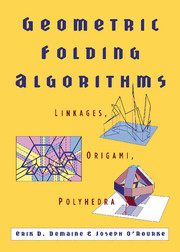Book contents
- Frontmatter
- Contents
- Preface
- 0 Introduction
- Part I Linkages
- 1 Problem Classification and Examples
- 2 Upper and Lower Bounds
- 3 Planar Linkage Mechanisms
- 4 Rigid Frameworks
- 5 Reconfiguration of Chains
- 6 Locked Chains
- 7 Interlocked Chains
- 8 Joint-Constrained Motion
- 9 Protein Folding
- Part II Paper
- Part III Polyhedra
- Bibliography
- Index
6 - Locked Chains
Published online by Cambridge University Press: 07 September 2010
- Frontmatter
- Contents
- Preface
- 0 Introduction
- Part I Linkages
- 1 Problem Classification and Examples
- 2 Upper and Lower Bounds
- 3 Planar Linkage Mechanisms
- 4 Rigid Frameworks
- 5 Reconfiguration of Chains
- 6 Locked Chains
- 7 Interlocked Chains
- 8 Joint-Constrained Motion
- 9 Protein Folding
- Part II Paper
- Part III Polyhedra
- Bibliography
- Index
Summary
INTRODUCTION
We know from Section 2.2.2 that configuration spaces of general linkages that are permitted to self-intersect, even in ℝ2, can have exponentially many connected components. On the other hand, we know from Section 5.1.1.1 (p. 59) and Section 5.1.2 (p. 66) that configuration spaces of open and closed 3D chains that are permitted to self-intersect have just one connected component. We also know from Section 5.3 (p. 70) that configuration spaces of planar chains have just one connected component when permitted to move into ℝ3 but forbidden to self-cross. We have until now avoided the most natural questions, which concern chains embedded in ℝd, with motion confined to the same space ℝd, without self-crossings. These questions avoid the generality of linkages on the one hand, and the special assumptions of planar embeddings or projections on the other hand.
The main question addressed in this context is which types of linkages always have connected configuration spaces. A linkage with a connected configuration space is unlocked: no two configurations are prevented from reaching each other. If a linkage in 3D or higher dimensions has a disconnected configuration space, it is locked. But for connectivity of the configuration space to be possible in 2D, we need to place an additional constraint, because planar closed chains cannot be turned “inside-out” as they could in Section 5.1.2 when we permitted the chain to self-intersect.
Information
- Type
- Chapter
- Information
- Geometric Folding AlgorithmsLinkages, Origami, Polyhedra, pp. 86 - 122Publisher: Cambridge University PressPrint publication year: 2007
